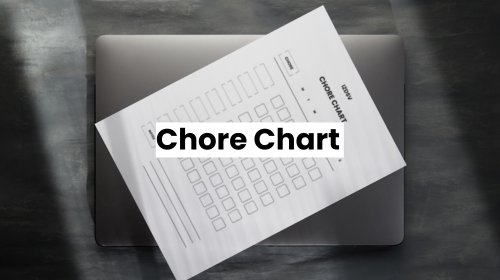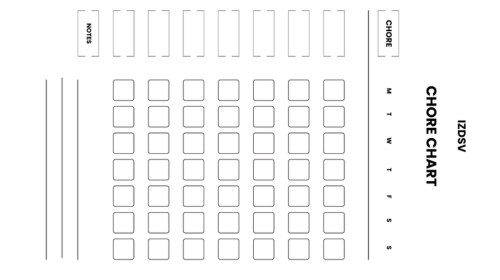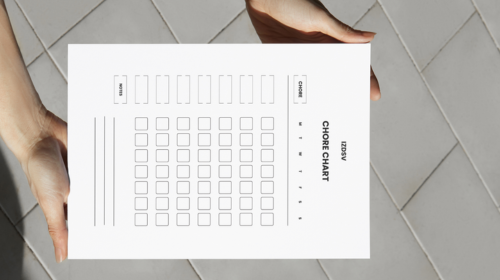Kids Chore Chart: Simple Digital & Printable Color-Coded Chore Charts
Why a Kids’ Chore Chart is Essential for Teaching Responsibility
A kids’ chore chart serves as a visual roadmap that transforms abstract concepts of responsibility into concrete, manageable tasks children can understand and complete. By providing structure and clear expectations, chore charts help children develop essential life skills while building confidence through consistent achievement of age-appropriate goals.
- Creates Clear Expectations: Children know exactly what is expected of them and when tasks need to be completed, eliminating confusion and reducing arguments about household responsibilities
- Builds Routine and Structure: Regular chores help establish daily and weekly routines that teach children the importance of consistency and time management
- Develops Work Ethic: Completing assigned tasks teaches children that contributing to family life is important and that everyone has a role to play in maintaining the household
- Teaches Accountability: When children see their name next to specific tasks, they learn to take ownership of their responsibilities and understand consequences for incomplete work
- Provides Sense of Achievement: Checking off completed chores gives children immediate visual feedback and a sense of accomplishment that builds self-esteem
- Introduces Time Management: Children learn to prioritize tasks, estimate how long activities take, and balance chores with other activities like homework and play
- Prepares for Adulthood: Early exposure to household management teaches practical life skills like cleaning, organizing, and maintaining living spaces
- Strengthens Family Teamwork: Chore charts show children they are valued contributors to family life, fostering cooperation and shared responsibility
- Builds Problem-Solving Skills: When faced with challenges in completing tasks, children learn to think creatively and find solutions independently
- Establishes Consequences and Rewards: Charts can incorporate both positive reinforcement for completed tasks and natural consequences for neglected responsibilities, teaching cause-and-effect relationships
Exploring Printable Chore Chart Ideas for Every Family
Printable chore charts offer incredible flexibility and customization options that can be tailored to fit any family’s unique needs, schedules, and values. The variety of available templates means parents can find designs that appeal to their children’s interests while incorporating the specific tasks and reward systems that work best for their household.
- Age-Based Chart Templates: Different designs for toddlers (picture-based), elementary kids (simple text), and teens (more complex responsibility tracking)
- Theme-Based Options: Charts featuring popular characters, sports themes, nature designs, or seasonal decorations that capture children’s attention
- Weekly vs. Daily Formats: Some families prefer daily check-off systems, while others work better with weekly overview charts that show the entire week at a glance
- Individual vs. Family Charts: Single-child charts for personalized tracking or family-wide charts that show everyone’s contributions
- Reward Integration Systems: Charts that include built-in allowance tracking, privilege earning, or point accumulation systems
- Seasonal and Holiday Variations: Special themed charts for summer break, school year, holidays, or family vacation periods
- Magnetic and Laminated Options: Reusable formats that can be updated weekly without printing new copies
- Digital-Print Hybrids: QR codes linking to apps or digital tracking while maintaining the visual appeal of physical charts
Benefits of Using a Color-Coded Chore Chart
Color-coding transforms a basic chore chart into an intuitive, engaging system that helps children quickly identify their tasks and track progress at a glance. This visual organization method reduces confusion and makes the chart more appealing to children who respond well to colorful, organized displays.
- Quick Visual Recognition: Each family member gets their own color, making it instantly clear which tasks belong to whom without reading names
- Priority Differentiation: Different colors can represent task difficulty levels, urgency, or importance (red for daily must-dos, yellow for weekly tasks, green for bonus chores)
- Progress Tracking: Using different colored markers or stickers to show completion status (green for done, yellow for in progress, red for overdue)
- Age-Appropriate Organization: Younger children who can’t read well can still navigate the chart using color associations
- Mood and Motivation Enhancement: Bright, appealing colors make chore completion feel more like a game than work
- Category Classification: Group similar tasks by color (blue for cleaning, green for outdoor work, purple for pet care)
- Seasonal Adaptability: Change color schemes to match holidays or seasons, keeping the chart fresh and interesting
- Reduced Conflicts: Clear color boundaries eliminate arguments about whose turn it is to do specific tasks
How to Create a Simple Chore Chart that Works
The key to a successful chore chart lies in starting simple and focusing on consistency rather than complexity, ensuring that both parents and children can easily understand and maintain the system. A well-designed chart should take less than five minutes daily to update and should feel more like a helpful tool than an additional burden for busy families.
- Start with 3-5 Basic Tasks: Begin with simple, age-appropriate chores like making beds, feeding pets, or clearing dishes, rather than overwhelming children with long lists
- Choose Age-Appropriate Responsibilities: Match tasks to developmental abilities (toddlers can put toys away, teens can do laundry)
- Use Clear, Simple Language: Write tasks in short, specific phrases like “Put dirty clothes in hamper” rather than vague instructions like “Clean room”
- Include Pictures for Non-Readers: Add simple icons or photos showing what completed tasks look like
- Set Realistic Timeframes: Allow reasonable time for task completion and avoid cramming too many chores into busy school mornings
- Create Consistent Check-In Times: Establish specific times (after breakfast, before dinner) when the family reviews and updates the chart together
- Build in Flexibility: Allow for sick days, special events, or schedule changes without making children feel like failures
- Keep Supplies Accessible: Store markers, stickers, or stamps near the chart so updating becomes effortless
- Celebrate Small Wins: Acknowledge effort and improvement, not just perfect completion
- Regular Review and Adjustment: Weekly family meetings to discuss what’s working, what isn’t, and how to improve the system
Incorporating Rewards into Your Family Chore System
A well-designed reward system transforms routine household tasks into opportunities for children to earn privileges, learn about goal-setting, and understand the connection between effort and positive outcomes. The key is finding the right balance between intrinsic motivation (doing chores because they’re important) and external incentives that encourage participation without creating dependency.
- Non-Monetary Rewards: Extra screen time, choosing the family movie, staying up 30 minutes later on weekends, or picking the dinner menu for special occasions
- Experience-Based Incentives: Special one-on-one time with parents, choosing a family weekend activity, or earning a sleepover with friends
- Privilege Systems: Earning points toward bigger rewards like a new toy, book, or special outing, rather than immediate gratification for each task
- Natural Consequences Approach: Focus on positive outcomes of completed chores (clean room feels better, family appreciates help) rather than external rewards
- Tiered Reward Structure: Small daily rewards for consistency, weekly rewards for completing all assigned tasks, and monthly rewards for going above and beyond
- Choice-Based Systems: Allow children to select from a menu of earned privileges rather than predetermined rewards
- Family Goal Rewards: When everyone completes their chores, the whole family earns something special, like pizza night or a trip to the park
- Allowance Integration: Link completed chores to earned allowance, teaching money management alongside responsibility
- Recognition and Praise: Sometimes verbal acknowledgment and family appreciation are the most meaningful rewards
- Avoid Over-Rewarding: Gradually reduce external rewards as children internalize the importance of contributing to family life
Ideas for Common Chores to Include in Your Chart
Age-appropriate chore assignments ensure children can successfully complete tasks while learning valuable life skills that will serve them throughout their development. Starting with manageable responsibilities builds confidence and creates positive associations with contributing to household maintenance.
- Toddler Tasks (Ages 2-4): Put toys in designated bins, place dirty clothes in the hamper, help set napkins on the table
- Preschool Duties (Ages 4-6): Make bed with help, clear own dishes after meals, water plants, match socks from laundry, dust low surfaces with microfiber cloth
- Elementary Responsibilities (Ages 6-10): Load/unload dishwasher, vacuum small areas, fold and put away own laundry, take out bathroom trash, organize backpack
- Middle School Tasks (Ages 10-14): Complete laundry process start to finish, prepare simple meals, clean bathrooms, manage own schedule
- Teen Responsibilities (Ages 14+): Deep clean rooms monthly, grocery shopping with a list and a budget, car maintenance checks, help with family meal planning
- Daily Maintenance Chores: Making beds, clearing dishes, feeding pets, tidying common areas, putting away personal items
- Weekly Deep-Cleaning Tasks: Vacuuming assigned rooms, bathroom cleaning, changing bed sheets, and organizing closets or drawers
- Seasonal and Outdoor Work: Raking leaves, shoveling snow, washing cars, gardening tasks, organizing garage or storage areas
- Pet Care Responsibilities: Daily feeding, walking dogs, cleaning litter boxes, and maintaining pet areas
- Kitchen Contributions: Meal prep assistance, loading/unloading dishwasher, wiping counters, organizing pantry items
Using Extra Chores to Teach Kids About Responsibility
Extra chores provide valuable opportunities for children to learn about going above and beyond basic expectations while developing work ethic and understanding the relationship between effort and rewards. These additional tasks help children experience the satisfaction of contributing meaningfully to family life beyond their regular responsibilities.
- Voluntary Service Projects: Allow children to choose additional tasks they’re interested in, fostering intrinsic motivation and personal ownership
- Emergency Response Training: Teach children to step up when family circumstances change (illness, busy periods, guests visiting) by taking on temporary extra duties
- Skill-Building Opportunities: Use extra chores to introduce new life skills like cooking, basic home maintenance, or organizational systems
- Earning Privileges: Connect desired activities or purchases to completed extra work, teaching the value of earning rather than simply receiving
- Family Crisis Support: Show children how families work together during challenging times by redistributing responsibilities temporarily
- Initiative Recognition: Praise children who notice and address needs without being asked, encouraging proactive thinking
- Seasonal Preparation Tasks: Deep cleaning before holidays, organizing for back-to-school, or preparing outdoor spaces for different weather
- Community Service Extension: Use extra household chores as practice for volunteer work or helping elderly neighbors
- Leadership Development: Allow older children to coordinate extra family projects, teaching management and communication skills
- Long-term Goal Achievement: Connect extra chore completion to bigger family goals like saving for vacations or home improvements
- Natural Learning Moments: Use extra chores to teach problem-solving when regular systems aren’t working or need improvement
- Building Work Ethic: Help children understand that successful people often do more than the minimum required in all areas of life
Printable Chore Charts for Easy Implementation
Printable chore charts offer the perfect solution for busy families who need an immediate, cost-effective way to organize household responsibilities without investing in expensive organizational systems. These ready-to-use templates can be downloaded, customized, and implemented within minutes, making them ideal for families who want to start building responsibility habits right away.
- Instant Availability: Download and print charts immediately without waiting for shipping or store visits, perfect for families ready to start today
- Cost-Effective Solution: Free or low-cost options eliminate the expense of purchasing pre-made organizational systems or custom charts
- Customization Flexibility: Many printable templates allow you to add family names, specific chores, and personal touches before printing
- Multiple Format Options: Choose from weekly, monthly, daily, or seasonal chart formats depending on your family’s planning style
- Trial and Error Friendly: Print different styles to test what works best for your family before committing to a permanent system
- Backup Copies Available: Keep digital files to reprint charts when they become worn, damaged, or when family needs change
- Portable Implementation: Print charts at home, office, or any location with printer access, making it easy to start anywhere
- Theme Variety: Access hundreds of design options from simple black-and-white to colorful themed charts matching children’s interests
- Size Customization: Print in various sizes from small personal charts to large family displays that work in your available space
- Integration with Other Systems: Combine with calendars, allowance trackers, or behavior charts for comprehensive family organization
Choosing Between Dry Erase and Magnetic Chore Charts
The decision between dry erase and magnetic chore chart systems depends on your family’s lifestyle, the ages of your children, and how you prefer to interact with organizational tools. Both options offer unique advantages that can significantly impact how consistently your family uses and maintains the chore tracking system.
- Durability Comparison: Magnetic charts typically last longer and resist wear better than dry erase surfaces, which can become stained or damaged over time
- Ease of Updates: Dry erase charts allow quick changes with markers, while magnetic systems require moving pieces but offer more tactile satisfaction for children
- Child Engagement Level: Younger children often prefer the hands-on experience of moving magnetic pieces, while older kids may find dry erase markers more mature
- Mess Factor: Magnetic systems eliminate concerns about marker caps, dried-out pens, or accidental marks on walls that can occur with dry erase options
- Visibility and Location: Dry erase charts can be hung anywhere, while magnetic options require metal surfaces like refrigerators, limiting placement options
- Cost Considerations: Initial investment varies, with basic dry erase boards being cheaper but magnetic systems often providing better long-term value
- Maintenance Requirements: Magnetic charts need occasional cleaning but no special care, while dry erase boards require proper markers and regular cleaning to prevent staining
- Customization Potential: Dry erase allows unlimited writing space and easy modifications, while magnetic systems may limit text space but offer colorful visual appeal
- Family Member Accessibility: Consider heights and motor skills of all family members when choosing between writing with markers versus manipulating magnetic pieces
- Storage and Portability: Dry erase charts can be rolled up or stored flat, while magnetic systems are typically permanent installations in one location
Utilizing PDF Formats for Easy Access and Customization
PDF formats provide the ideal balance of professional appearance and user-friendly customization, allowing families to create polished chore charts that look great while being simple enough for anyone to modify and print. These versatile files work across all devices and operating systems, ensuring consistent appearance regardless of how or where you access them.
- Universal Compatibility: PDF files open correctly on computers, tablets, phones, and any device, ensuring consistent formatting across all platforms
- Professional Appearance: PDFs maintain clean lines, proper fonts, and attractive layouts that look polished when printed or displayed digitally
- Editable Text Fields: Many PDF chore charts include fillable forms where you can type family names, chores, and dates directly into the document
- Print Quality Assurance: PDFs preserve high resolution and proper sizing, ensuring charts print clearly without pixelation or formatting issues
- Multiple Device Access: Save files to cloud storage and access from any device, making it easy to update charts from phones, tablets, or computers
- Version Control: Keep master copies unchanged while creating customized versions for different seasons, ages, or family situations
- Password Protection Options: Secure sensitive family information or prevent accidental changes by protecting PDF files with passwords
- Annotation Capabilities: Add notes, highlights, or digital signatures directly to PDF charts using free reader applications
- Email and Sharing Ease: Send charts to co-parents, caregivers, or family members via email while maintaining formatting integrity
- Printing Flexibility: Scale PDFs to fit different paper sizes or print multiple copies per page for smaller personal charts
- Digital and Physical Hybrid Use: Display PDFs on tablets or computers for digital tracking while also printing physical copies for refrigerator posting
- Long-term Accessibility: PDF format ensures charts remain usable even as software and technology change over time




